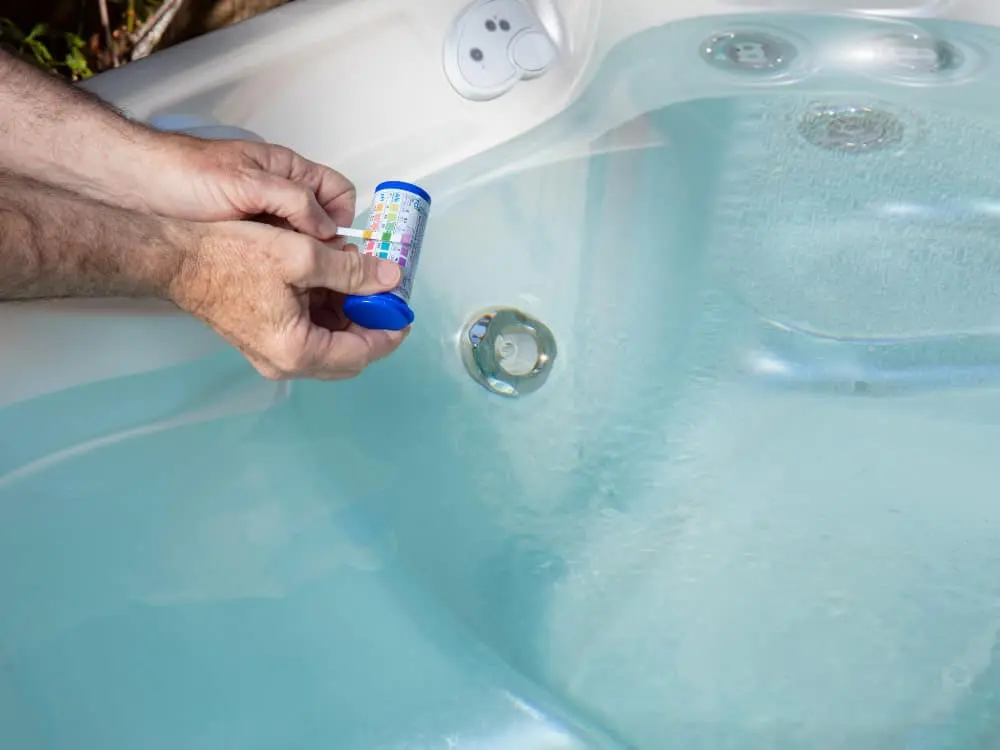If a hot tub has too much chlorine it can not only damage the unit…

Bromine or Chlorine: Which One is Best for Your Hot Tub?
Which is better for your hot tub; Bromine or Chlorine? Find out the 10 key differences between them and make an educated choice.
Are you considering using bromine or chlorine to sanitize your hot tub? Both hot tub chemicals are effective at keeping your hot tub clean and safe to use, but there are some key differences between the two that you should consider before making a decision.
People use hot tubs for many reasons, but here are the three most common:
- 33.3% of hot tub owners use their hot tub at night to help with their trouble sleeping. The rise in body temperature followed by the drop in temperature when they get out helps to bring on sleep.
- 49% of owners use the warm water to improve their recovery from exercise. After a gym session or a tough workout, owners jump in the tub to ease muscle soreness.
- 20% of owners use their hot tub to boost recovery from injury. Hydrotherapy provides water pressure delivery exactly where it’s needed to provide pain relief.
We have a whole article full of interesting hot tub facts. The key point here is that using a hot tub for positive reasons shouldn’t mean worrying about the chemicals in the water.
In this blog post, we’ll explore the pros and cons of using bromine and chlorine in your hot tub so that you can make an informed decision about which one is right for you. Keep reading to learn more!

Oxidizers vs Ionizers – How They Work?
You might think that hot tub sanitation is just as simple as pouring a bag of white powder into your spa water, but the truth is that it’s much more complicated than that. Hot tub sanitization can be accomplished using two different methods: oxidation and ionization.
While both methods aim to sanitize hot tub water, they work differently. An oxidizing agent, or oxidant, gains electrons and is reduced in a chemical reaction. On the other hand, ionizers release negative ions into the water. These ions electrically charge other particles in the water.
The Chlorine – Oxidizer
Chlorine is a powerful sanitizer that quickly and effectively kills germs. It does this by oxidizing and destroying bacteria and other harmful organisms in the water. This means that chlorine helps to remove waste left behind after neutralizing contaminants in the pool. It does this by breaking them apart and forcing them out of the water in the form of a gas.
This makes chlorine a great choice for swimming pool water or hot tubs used by many people because it can quickly get rid of germs and keep the water clean.
The Bromine – Ionizer
Bromine, on the other hand, is an ionizer, which means it works by releasing ions into the water that kill bacteria and viruses. Bromine is a bit gentler than chlorine and doesn’t have the same harsh odor or side effects. It’s an excellent choice for people with sensitive skin or those who want to avoid the strong smell of chlorine.
Bromine is a powerful disinfectant that can kill many pathogens. It’s effective against tough waterborne viruses, such as poliovirus and rotaviruses, as well as a wide spectrum of bacteria.
However, bromine does not oxidize ammonia or other nitrogen substances. This means that it may not be effective against certain contaminants that contain these substances.
Bromine vs Chlorine Differences
While people think they are interchangeable, bromine and chlorine have significant differences. The final choice will come down to personal preferences. But to help you get on with the choice, let’s dive into the differences.
Elements vs. Compounds
Chlorine and bromine are both elements on the periodic table that belong to the same chemical family of ‘oxidisers’. They disinfect by oxidizing (chemically degrading) microbes. However, they’re typically not used in their pure form to sanitize hot tub water. Instead, they’re used as compounds:
- Chlorine tablets
- Bromine granules
These compounds are more stable and easier to handle than pure chlorine or bromine. Bromine can be generated at low concentrations in water by mixing active chlorine with a relatively harmless salt of bromine called bromide.
Effectiveness and Reactivity
When it comes to effectiveness, both bromine and chlorine are good at keeping tub water clean. However, chlorine is more reactive and works faster, making it better suited for large bodies of water like swimming pools. Bromine, on the other hand, is more stable and works better in hot tubs where the water temperature is higher.
- Liquid bromine at 1.0 ppm is as effective as 0.6 ppm of available chlorine hypochlorite control with E. coli as the test organism.
- Bromine is more effective than chlorine at high pH levels.
- Bromine remains stable in warm water above 75°F while chlorine is more effective in temperatures as low as 65°F.
How the Body is Affected
Chlorine can be harsh on the skin and eyes, especially for people with sensitive skin or respiratory issues like asthma. Some known effects of chlorine on people using hot tubs include:
- If the chlorine level is too high, it can be rough on the skin, eyes, and hair.
- Chloramines can cause breathing difficulties if they linger in the humid air around the hot tub for long.
Bromine is gentler on the skin and doesn’t have the same strong odor as chlorine. However, bromine can linger on the skin longer, which some people find annoying. Some known effects of bromine on people using hot tubs include:
- High levels of bromine in a hot tub can cause dizziness, nausea and vomiting, a burning sensation in the mouth, throat pain, stomach pain and stools with blood.
It’s important to note that when bromine and chlorine are mixed together they can form halogenated hydrocarbons which can be harmful to your skin and eyes and can cause respiratory problems. Mixing bromine and chlorine can also lead to unstable pH levels in the hot tub which can make water uncomfortable to soak in.
Water Transparency
Both bromine and chlorine are effective at keeping hot water clear and transparent. However, bromine is better at maintaining water clarity in high-temperature environments like hot tubs.
Application
Chlorine is typically applied to hot tub water as tablets or granules, while bromine is often used as tablets or in a floating dispenser. Both methods are effective at sanitizing hot tub water, but tablets or a floating dispenser are more convenient.
Dosage Amounts
When it comes to dosage, you’ll typically need to add more bromine to your hot tub than chlorine. For every 500 gallons of water, you need to add 4 tablespoons (or 2 ounces) of chlorine. For hot tubs and spas, you should add 3 tablets for every 300 gallons of spa water using a floating tablet feeder or automatic brominator installed on the hot tub. However, bromine lasts longer in water than chlorine, so you won’t need to add it as frequently.
Shocking Procedure
If you’re experiencing issues with your hot tub water, like cloudiness or a strong odor, you may need to shock your hot tub with a large dose of either chlorine or bromine. Both chemicals are effective at shocking your hot tub water, but you’ll need to follow the manufacturer’s instructions carefully to avoid damaging your hot tub.
High Temperatures:
Hot tubs are typically kept at higher temperatures than swimming pools, which means that the water is more conducive to the growth of bacteria and other contaminants. This is why it is especially important to use a sanitizer that is effective at higher temperatures.
Bromine is generally more stable than chlorine at high temperatures, making it a better choice for hot tubs. However, both chlorine and bromine can be effective at high temperatures as long as they are properly maintained.
Costs
When it comes to cost, bromine is generally more expensive than chlorine. Bromine costs roughly $10 per lb (depending on where you buy it), whereas chlorine (dichlor) is roughly $5 per lb. In terms of how often they need to be added to a hot tub, chlorine or bromine should be added 2-3 times per week. However, how much sanitizer you need to add also depends on how often the hot tub is used and which sanitizer you prefer to use. Chlorine breaks down in heat faster and will need to be added a little more often. Your choice will impact the running costs of a hot tub.
Environmental Impact:
Both chlorine and bromine can have an impact on the environment if they are not used and disposed of properly. Chlorine can react with organic matter in water to form harmful byproducts, while bromine can persist in the environment and can have a negative impact on aquatic life.
If you are concerned about the environmental impact of your hot tub, there are alternative sanitizers available that are more eco-friendly, such as mineral-based sanitizers.
Is PH an important consideration in bromine vs. chlorine for my hot tub?
Yes, pH is an important consideration when it comes to using bromine or chlorine in your hot tub. Here are some key points about each chemical:
- Bromine: Bromine will gradually reduce the pH and alkaline levels of the hot tub over time. The pH level of bromine is lower than chlorine which means that bromine will do a much better job balancing the overall chemistry of the water. Your hot tub bromine level should always be between 3-5ppm (parts per million).
- Chlorine: Chlorine is used to sanitize hot tub water and will also reduce the pH levels in your hot tub. However, it is not as potent as bromine. The recommended level of chlorine in your hot tub is between 1 and 3 parts per million (ppm).
Both bromine and chlorine can lose effectiveness at specific pH levels.
- Bromine: Bromine is more effective than chlorine at high pH levels. Hypobromous acid is a very effective biocide, as are the other bromine compounds and because all bromine compounds have biocidal properties, it offers a broader kill spectrum.
- Chlorine: Chlorine is more effective at lower pH levels. As you move up in pH, it diminishes the sanitizing power of free chlorine in the water, making it weaker the further up in pH you go.
It’s important to keep water balanced with a pH level between 7.2 and 7.8 for optimal effectiveness of both chemicals.
What is the best sanitizer type for your hot tub – granules or tablets?
The best sanitizer type for your hot tub will depend on your personal preference and the specific needs of your hot tub. Granules can be more convenient to use and can be added directly to the water, while tablets are slower dissolving and are typically used in a floating dispenser.
FAQ
Can you switch from chlorine to bromine in a hot tub?
Yes, you can switch from chlorine to bromine in your hot tub. However, you will need to drain and clean your hot tub before making the switch, as chlorine and bromine should not be mixed together.
Which is healthier: chlorine or bromine?
Both chlorine and bromine are safe and effective sanitizers when used properly. The choice between the two will depend on your personal preferences and the specific needs of your hot tub.
Which is better for your skin, chlorine or bromine?
Bromine is generally considered to be gentler on the skin than chlorine, making it a better choice for individuals with sensitive skin.
Is it OK to mix chlorine and bromine?
No, it’s not okay to mix chlorine and bromine because they can react with each other and cause a dangerous chemical reaction. Mixing the two can release toxic fumes and cause a fire hazard. Therefore, it’s essential to use only one sanitizer type in your hot tub and avoid mixing them.
Why did Canada ban bromine?
Canada banned the use of bromine in hot tubs and swimming pools in 2012 due to concerns over its impact on the environment. Bromine can contribute to the formation of ozone, which can harm the environment and human health. Additionally, bromine is more difficult to remove from wastewater treatment plants than chlorine, making it a less environmentally friendly option.
Low chemical Hot Tub Alternatives
If you’re looking for a hot tub without chemicals or a low-chemical alternative to traditional hot tub sanitizers, there are several options available. One popular option is ozone generators, which produce ozone gas that acts as a natural sanitizer. Another option is mineral-based sanitizers, which use copper and silver ions to kill bacteria and algae. Additionally, some hot tub owners choose to use enzymes, which break down organic material in the water, reducing the need for chemical sanitizers.
Which is better: bromine or chlorine for a hot tub?
Choosing between bromine and chlorine for your hot tub depends on your personal preferences and needs. Bromine could be better if you are sensitive to the effects of chlorine. On the other hand, bromine might also make you uneasy about the environment or be hard to procure if you live in Canada.
For more thorough advice, or even to test how different water feels when one or the other chemical is used, get in touch with your local hot tub dealer. The friendly staff at Epic Hot Tubs located in Raleigh & Durham, NC will be happy to help you choose the best chemical for your tub and family.

Interested in a Hot Tub or Hot Tub Chemicals in North Carolina?
Call 888-884-3742 or Fill Out the Form Below to Contact Us Today!
Manny Brambila
Manny has been in the Pool & Spa industry for over 15 years and is considered a pool, swim spa, & hot tub expert. He has been a Certified Pool & Spa Operator (CPO) since 2009 and worked 15 years in aquatic training and development for the largest pool chemical and customer care company. He also has been an outside consultant for the Pool and Spa industry in Chicago, New York and Los Angeles since 2018. In the past few years Manny has become Director of Operations for Epic Hot Tubs with a priority of providing customers with the most reliable information and best service possible.


